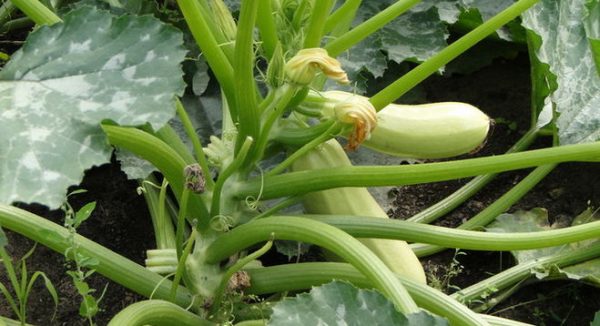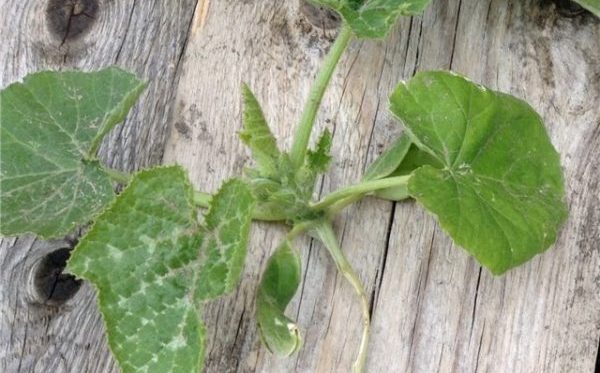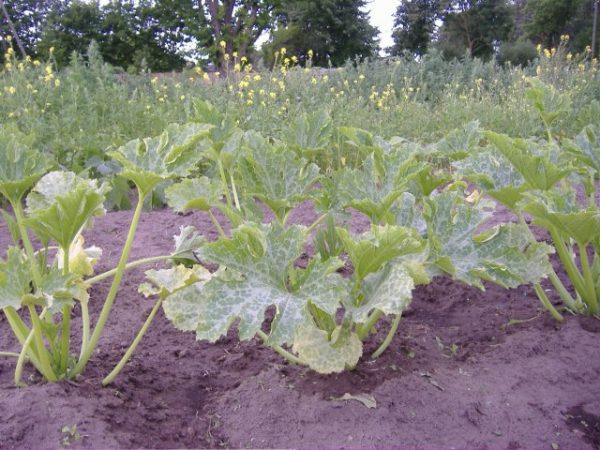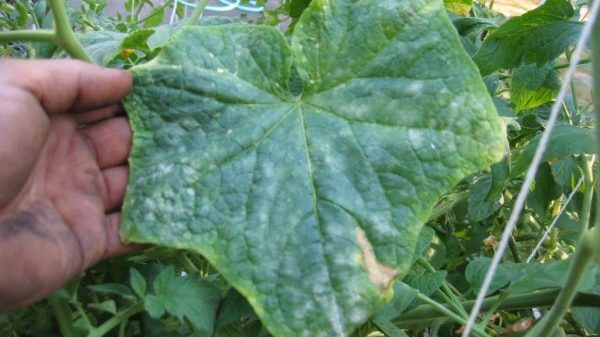Why do white spots appear on zucchini leaves?
Content
What are these stains
White spots can have a different pathogenesis: they can become a symptom of a fungal disease or signal the effect of a harmful insect on a vegetable. Such spots can be identified with the naked eye - they cover the leaf plate in abundance, creating a marble texture, less often they spread to the stalks of zucchini. Below is a list of the most common diseases and pests that leave such marks on the leaves.
Spider mite
This insect is found in abundance in greenhouses and greenhouses. Having a small body size, only 0.4 mm, spider mites can be skipped on especially dense bushes. The tick has an oblong body, its eggs are round, greenish or whitish in color. Colonies of spider mites settle on the lower part of the leaf, rather quickly starting to braid the living part with a thin white cobweb.
Damaged leaves are covered with white dots, which eventually expand into spots of indefinite shape. Within a few days, the leaf turns yellow and then dies off. If nothing is done, the plant will die. Spider mites are most active in June-August, when a stable high air temperature is established, which they like, at this time they can appear in the open field. Ticks prefer to wait out the off-season under plant debris, in various crevices, frames or in the ground at a depth of 5-6 cm.
Video "Tips for growing zucchini"
An illustrative video with tips for growing zucchini that will help you avoid diseases.
Powdery mildew
One of the most common fungal diseases of pumpkin plants is powdery mildew. Fungal spores develop and parasitize on plant tissues, mainly leaves, in conditions of high humidity or with frequent dew. As soon as the weather becomes cloudy, rainy, and the thermometer drops to + 18 ° С, wait for the appearance of powdery mildew. One of the factors that favorably affect the spread of the disease is the oversaturation of the soil and plants with nitrogen fertilizers, without regular watering.
Round spots appear on the leaves, white or whitish-gray in color. After several days, the spots increase in size, a little later they become covered with a mealy bloom, which spreads abundantly throughout the entire leaf blade and stem. Infected leaves become lighter, up to a yellowish-white color, wither, and subsequently die off. The stems lose their elasticity, become lethargic and brittle, and often completely die off. If powdery mildew appeared on the plant during fruiting, then with a high probability the fruits will ripen ahead of time, but will lose their taste, acquiring a bitter or sour taste.
Powdery mildew spores are frost-resistant, overwinter on plant debris or in the upper layers of the soil.Often, perennial plants are chosen for wintering, which are not cut to the root in late autumn. The greatest danger is posed to plants in greenhouses.
Gray rot
Another fungal disease, the manifestation of which is whitish spots and dots on the leaves of zucchini - gray rot. First of all, it infects the leaves and ovaries of zucchini, leading to their death. Dark spots appear on the plant, powdered with a whitish-gray bloom. After a few days, these spots become wet, soft, slimy, plaque begins to actively spread to neighboring plants along with pollen.
The trigger for the appearance of gray rot is sudden changes in air temperature, for example, at the end of May and August. It also pushes for the development and spread of high humidity in the air and soil, since warm humid air is ideal conditions for the life of the fungus. As in the case of powdery mildew, gray rot is likely to be favored by plants with an excess of nitrogen, since it stimulates the development of green mass of the culture, thickening of the bushes. Spores of gray rot winter well on plant debris and in the upper layers of the soil, therefore they actively affect plants that are planted in the same place for several years.
White mosaic
In terms of danger to the pumpkin family, white mosaic occupies a leading position. Infected zucchini leaves become stained white and yellow in a mosaic pattern. Most often, over time, they fade into white, only the veins of the leaf remain green. The structure of the leaf does not change - it does not dry out, does not deform, does not curl into a tube.
With a disease, the growth of the plant stops, the leaves and stems begin to shrink, with fruiting, small deformed fruits with white stripes, sometimes with growths, are formed. The oppression of knots and lashes of zucchini is noted, their fragility and fragility increases. White mosaic develops in conditions of sharp changes in air and soil temperatures. Watering with cold water, the temperature of which is much lower than the temperature of the earth, causes the virus to become active. The disease is transmitted through the root system and juices - from an already infected plant to a healthy plant. In the risk zone, plants planted twice in a row in the same place, attacked by melon aphids or grown from seeds of diseased plants.
Control methods
As you know, it is better to carry out prevention than to treat plants, but if you have not previously encountered the problem of stains on zucchini, then it's okay. Perhaps in the war against disease, you will lose a few plants, but you will save all the rest of the plantings. Spots on zucchini leaves are a symptom, let's figure out what you need to do to nullify them.
To drive away spider mites from the leaves, spray the beds with infusion of onion peels or garlic every day. Insects are not very fond of such treatment, therefore, disturbed, they will stop actively eating vegetables. To prepare the husk infusion, pour 700 g of the husk with ten liters of water, boil, let it brew for 6-8 hours, strain and start processing the plantings. For garlic infusion, you will need to grind 5-6 heads of garlic into gruel, pour them with four liters of hot water, let it brew for 2-4 hours, strain and apply.
Weed and thin out your zucchini plantings regularly. Feed regularly to build up immunity in plants. Use chemicals such as Keltan or Isophene.
It will be more difficult to get rid of powdery mildew on zucchini leaves. First, you will need to dig up the pumpkin tops, weeds, and diseased plants around the garden or greenhouse. Then the remaining plants must be sprayed with fungicidal preparations, for example, using "Isofen", "Topsin-M" or "Topaz". To prevent the fungus from taking root, spray the plants with a copper oxychloride solution.
To prepare it, mix 40 g of raw materials with ten liters of warm water. It is imperative to transplant zucchini to a new place every year, maintain a stable temperature in greenhouses, and water the plants with warm water.
It is possible to expel gray rot from the beds only by complex measures: regular weeding, application of a complex of mineral and organic fertilizers, treatment with fungicides ("Rovral", "Bayleton"). Treat diseased plants with whey, which is easy to prepare at home: dilute 1 liter of sour milk with 3 liters of warm water, mix thoroughly, let it brew for 3-4 hours, and then spray the zucchini. At the time of treatment, it is important to stop watering, remove all parts of the plant affected by the disease, and also thin out the plantings.
Overcoming the white mosaic is probably the most difficult thing - it is necessary to replace the contaminated soil with a new, disinfected and fertile one. It is necessary to take seeds from healthy plants, carefully process them before sowing. Weeding, spraying plantings with onion peel infusion or soapy water to drive away the aphid carrier of the virus. Try to maintain a stable air temperature, water the plants with warm water. For almost all diseases of the pumpkin family, prevention and control methods are the same: do not water the plants with cold water, do not feed them with nitrogen fertilizers, prevent plantings from thickening, and regularly treat them with fungicides.
Video "Solution for getting rid of parasites and diseases in zucchini"
An illustrative video with instructions for creating a solution that will help avoid the appearance of pests and diseases on zucchini.







